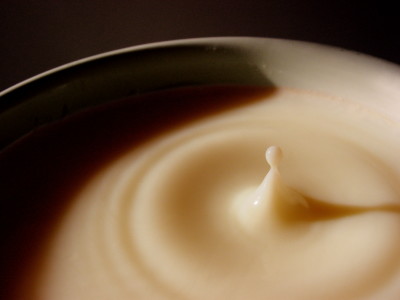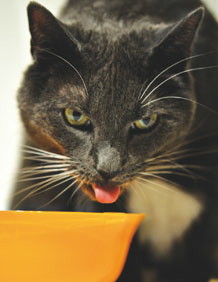Why doesn't the cat's chin get wet after drinking milk?

Many of you may have been surprised by the agile and supple movements of cats and the amazing sense of balance that they occasionally show, but their elegance seems to be demonstrated when drinking milk.
A civil engineer at the Massachusetts Institute of Technology, who was impressed by how a domestic cat swiftly moved his tongue and drank milk without soiling his hair and spilling a drop, spent three and a half years studying with fellow physicists and mathematicians. , Elucidated the amazing mechanism by which cats drink milk without getting their chin wet.
Study reveals the subtle dynamics underpinning how felines drink --cee.mit.edu
https://cee.mit.edu/study-reveals-the-subtle-dynamics-underpinning-how-felines-drink/
In 1940, Dr. Harold Edgerton of MIT (of the milk crown ) said that cats licking liquid lickingly rounded the tip of the tongue to the back side like a 'J' and put it on the liquid from the front side of the tongue first. It was known for its slow-motion footage of a cat drinking milk, taken by an electronic flash and stroboscope photographer , who is famous for photography. By the way, the short documentary ' Quicker'n a Wink ' including the video of this cat won the 1941 Academy Award.

However, high-speed footage taken by MIT's Associate Professor of Civil and Environmental Engineering, Roman Stocker and others, shows that cats are touching milk only on the front side of their tongue, rather than having their tongue soaked in milk first. Became clear.
Instead of squeezing the milk with a rounded tongue, the cat touches the tip of the tongue slightly to the surface of the milk and pulls it up quickly. For a short time when the inertia acting on the milk pulled up while sticking to the tongue is superior to gravity, a thin pillar of milk is formed between the milk body in the bowl and the tongue, and the inertial force loses gravity and the milk Before the pillars snap, the cat closes its mouth and catches the milk in the air. In the case of a domestic cat, it is said that this movement is repeated at a pace of about 4 times per second on average.
The slow motion video taken by Professor Stocker and others is from the following.
YouTube --Cutta Cutta (12x slower)

Cutta Cutta (8 years old), the cat of Professor Stocker, who started the research with the model in the above video. The name 'Cutta Cutta' means 'star' in Aboriginal terms, but it's a whimsical cat that is willing to keep the cameraman waiting, just like the big star of the silver curtain, and Professor Stocker and colleagues said Cutta Cutta. Even if he prepared milk in front of him and held the camera, he sometimes did not drink it until several hours later.

Cutta Cutta's owner, Dr. Stocker, an associate professor at MIT's Department of Civil and Environmental Engineering, who specializes in biophysics of marine microorganisms, and a physicist who also specializes in soft solid mechanics, an associate professor at MIT's Department of Civil Engineering and Mechanical Engineering. The team consists of Dr. Pedro Miguel Reis of Pedro Miguel Reis, Dr. Sunghwan Jung, who specializes in biofluid mechanics at the Virginia Institute of Technology , and Dr. Jeff Aristoff, a mathematician who specializes in liquid surface mechanics at the Department of Mechanical and Aerospace Engineering at Princeton University. A large number of domestic cats , including the above, drink milk, and with the cooperation of Zoo New England , the beast of the cat family (Lion , Tora, and Jaguar ) was also photographed at high speed and their movements were analyzed. In addition, it is said that the video of a lion drinking water on YouTube was also analyzed and data was obtained, but it is probably the first paper published in Science magazine to use YouTube video as research material. That thing.
Below is a video of the lion.
YouTube --Male lions drinking at night

By analyzing these high-speed images, Dr. Stocker and his colleagues gained the speed at which the tongue moves and the pace at which the tongue touches and pulls up the liquid, and then the Froude number (the inertial force of the fluid). By a mathematical model using (dimensionless number representing the ratio of gravity), we discovered that both small domestic cats and large lions drink in a perfect balance between the gravity acting on the fluid and the inertia that pulls the fluid. bottom.
'The amount of liquid that a cat can drink each time it closes its mouth depends on the size of the tongue and the speed at which the tongue moves. The results of this study show that each cat drinks around a' human lick. ' It suggests that we are optimizing the speed at which we move our tongue to maximize the amount of liquid we can do. When it comes to fluid dynamics, cats may be much smarter than people think. 'Dr. Aristoff said. Large cats such as lions and tigers have a large tongue, so they are licking at a slower pace than domestic cats in order to balance inertia and gravity.
Dr. Stocker and his colleagues also created a device to reproduce the movement of the cat's tongue at various speeds, and tested the hypothesis of 'optimizing the tongue speed.'
YouTube --Experiment (100x slower)

Dr. Sunghwan Jung, who specializes in bio-fluid mechanics, said, 'At the beginning of the project, we were not yet sure if fluid mechanics would be involved in cats drinking water, but as research progressed. I was impressed with the hydrodynamic beauty of the cat's drinking mechanism. '
This research follows a traditional course as a scientific study of natural phenomena, in which hypotheses are made, observations and experiments, and mathematical models are used to answer questions that are felt by observing a certain phenomenon. It was said that it was done.
'This project, which started three and a half years ago, does not require research funding from the government or sponsor companies, does not allow graduate students in the laboratory, and does not use state-of-the-art equipment, unlike ordinary research. But I was able to show my teamwork and creativity without regret. Science is a job for me, but it is also my passion. Science shows us the phenomena that we usually see casually from a different perspective. It makes me understand how things work, 'said Dr. Stocker, owner of Cutta Cutta.
Related Posts:







